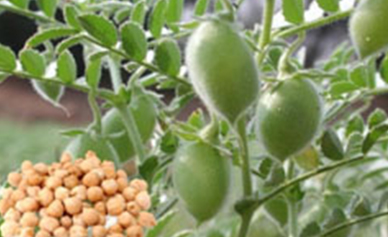Bengal gram

The Indian grams have been classified in 2 broad groups – Desi or brown gram & Kabuli or white gram.
Desi or brown gram is the most widely grown group and its plants are small, erect with good branching. Kabuli or white gram is grown in lesser area than the brown gram and its plants are erect taller than brown gram with moderate branching. Both these types produce about 50-100 pods/plant and each pod having up to 2 seeds.
Climatic Requirements
Chickpeas requiring cool climate for growth and high temperature for maturity are grown between 10-320N latitude in the country in the winter season. However, it is a crop of spring season beyond the sub-continent.The crop performs better at 24-320 C temperature. This crop with deep root system can be grown on residual soil moisture in areas with 600-1000 mm annual rainfall. Heavy rains at germination and flowering are detrimental to the crop. Hail-storms at maturity are not desirable. Chickpea is quantitatively long-day plant requiring photo period >12 hours.
Soils and its preparation
Gram is grown practically on a variety of soil types ranging from very light to heavy ones. In north India, it is cultivated on sandy loam to clay loam soils whereas in south on Deccan plateau and central India or Maharashtra, gram is raised on black cotton soils. The clay loams are the best. Gram needs cloddy and rough seed-bed for good aeration in root zone. Hence, a little land preparation is required.
Time of Sowing
The optimum time of sowing vary from mid-October to mid-November. Rain-fed crop should be sown at the earliest in October. Under irrigated conditions, second fortnight is the best. The sowing time in different states vary as is given below.
| States | Rain-fed | Irrigated |
|---|---|---|
| Punjab and Haryana | Second to third week of October | Fourth week of October to 15 November |
| Rajasthan | First to 15 October | 15-30 October in south and south-eastern Rajasthan; 25 October-15 November in Ganganagardistrist |
| Bihar and Gujarat | 15 October to first week of November | First fortnight of November |
| Madhya Pradesh Maharashtra, Uttar Pradesh, Karnataka, Jammu-Kashmir and Tamil Nadu | First fortnight of October | End of October to first week of November |
Method of Sowing
Broadcast of seeds should be avoided especially under rainfed conditions. The seeds should be sown in furrows behind the country plough, but the best method is to drill the seeds either by seed drill or by malabasa at a depth of 8-10 cm. Under irrigated conditions, shallow sowing (5-6 cm) is recommended.
Water Management
Gram is mostly grown as a rainfed crop and is capable of extracting moisture from deeper layers. Most of its roots are usually confined within upper 2 feet of soil. However, where irrigation facilities are available, one pre-sowing irrigation (palewa) may be given for proper germination and better crop growth. In absence of winter rains, one irrigation each at pre-flowering and pod development stage may be applied. In no case, first irrigation should be given earlier than 4 weeks after sowing. No irrigation should be applied at flowering time of crop. The crop should always be given light irrigation (50-60 mm) because heavy irrigation is harmful to crop. The water requirement of the crop varies from 250-400 mm. At present 30.6% of total chickpea acreage of the country is under irrigation.
Nipping
Under irrigated condition, crop may sometimes make vigorous vegetative growth adversely affecting the development of reproductive structures. The practice of nipping may be required under such conditions. In this process, the apical buds of the crop are plucked, when the plants get a height of 15-20 cm i.e., 50 days after sowing. This helps in developing more lateral branching bearing flowers and pods.
Weed Control
Gram, being a dwarf statures crop suffers severely by weed infestation. Uncontrolled weeds may limit chickpea yields by 40-87%. The initial 2 months period is critical for crop-weed competition. The best time for weeding and hoeing is between 25-30 days after sowing. If the weeds persist after first weeding, another weeding should be done at about 60 days after sowing. Weeds can also be controlled effectively by herbicides.
Bengal Gram (Chickpeas) – All India Area and Production
|
|
2018-19 |
2019-20 | 2020-21 | 2021-22 | 2022-23 |
| Area (Million Hectares) |
10.56 | 9.54 | 9.69 | 9.99 | 10.74 |
| Production (Million Tonnes) |
11.38 | 9.94 | 11.08 | 11.91 | 13.54 |
Source: FAOSTAT
Bengal Gram (Chickpeas) Exports from India
|
Year |
2019-20 |
2020-21 | 2021-22 |
2022-23 |
2023-24* |
|
Value |
731.52 | 1,018.89 | 813.04 | 2,549.06 | 1,383.29 |
*2023-24 (April-January)
Source:Department of Commerce, Ministry of Commerce and Industry, Govt. of India
https://tradestat.commerce.gov.in
